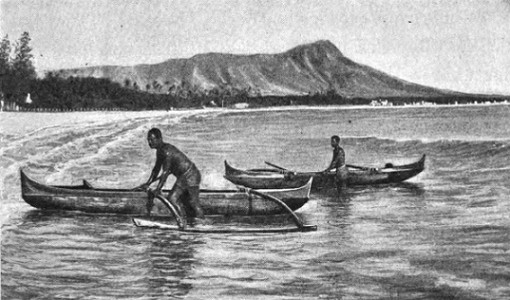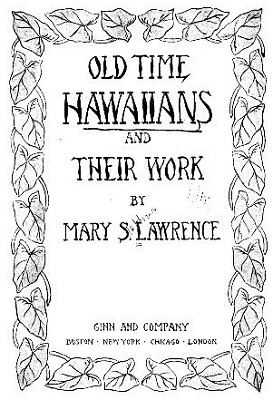
mary lawrence : surf riding in hawai'i, 1912
| home | catalogue | history | references | appendix |
 |
surfresearch.com.au
mary lawrence : surf riding in hawai'i, 1912 |
Open Library
http://openlibrary.org/books/OL6545563M/Old_time_Hawaiians_and_their_work
See:
1912 Mary Charlottee
Alexander : Story of Hawaii.
Extracts and
illustrations from Story of Hawaii., American Book Company,
New York, c1912.
Page 3
One day the children
were surf riding, " See the little keiki, " exclaimed Lehua, who
was taking a sun bath with Manuia after a vigorous swim.
Manuia looked.
There was Keikiwai
standing on his surf board, balancing himself fearlessly as he rode in
on a huge breaker.
Then he changed
his position and stood on his head.
" Why, that is
better than I can do," said the proud father, excitedly.
"But wait! he
will have a tumble before he reaches shore."
Page 4
On came the child.
Every one stopped
to watch him, for it took much skill to keep his position.
As he neared
the shore he gave his board a mighty push which sent it upon dry land,
and then dived into the water and disappeared from sight.
The people cheered,
for few experienced men could have done better in so rough a sea.
" He is surely
a child of the sea god," said Manuia ; " I will take him to fish with Kaipo
and me."
Page 23
Page 30
The making of
a canoe was important, and needed the favor of the gods.
So the canoe
builders went first to the kahuna, who offered sacrifice and prayers to
different gods.
The kahuna then
went with the men to help them find the right tree in the forest; sometimes
they climbed several thousand feet above sea level before they found it.

OUTRIGGER CANOE
For the best canoes
he chose koa, which is a hard wood.
He watched the
elepaio, or woodpecker, and chose some tree that the bird did not
bore into.
This was rudely
shaped, and then ropes were tied to it, and it was dragged down to the
seashore.
The canoe was
made long and narrow so that it would go swiftly.
It was hollowed
out with a special
Page 31
right-handed or left-handed adz which had been invented by one of the canoe gods.
The gunwale, or
moo, was made of strips of wood fastened to the upper edge to meet
at bow and stern.
It was usually
six or eight inches wide, and was tied with cord or fastened with wooden
pegs, and was put on to make the canoe higher.
The moo
was made of a yellow wood called ahakea and remained the natural
color when the body of the canoe was painted black.
[illustration]
PADDLE
The ama, or outrigger, was a steadier, made of a curved log of wiliwili, which was fastened to the canoe with iako, or branches of the hau tree.
Most of the canoes
were less than 50 feet long.
The fishing canoe
of Kamehameha V is in the Bishop Museum.
It held four
men besides the king, and its dimensions are: length, 35.5 feet; depth
outside, 27 inches; inside, 23.5 inches; width outside, 23 inches; inside,
17.5 inches; center of canoe to center of outrigger, 10,7 feet.
The paddle was usually 5 feet long, the blade 12 x 20 inches.
Page 32
The launching
of a canoe needed the services of the kahuna.
A sacrifice was
offered, and then tlie owner and the kahuna stood at the bow of the boat.
The latter recited
a long prayer while the canoe was being launched.
Any noise at
that time was a bad sign; perfect silence meant that the canoe was safe.
Page 85
The old-time Hawaiians
were fond of games, and their outdoor sports made them strong and alert.
The games in
the water heljaed them to be better fishermen.
Little babies
were taught to swim, and they always liked to play in the water.
Boys became experts
in jumping from high precipices, and in diving, floating, and swimming
under water or with their feet interlocked.
Surf riding is
still the national sport.
Many of us know
by experience how hard it is to keep our board

PAPA HOLUA
[reformatted]
on the edge of
the wave and to steer it so that the wave carries us along.
In those days
the boards were larger, and riders could change their position while surfing.
They liked to
stand as they rode in.
Sometimes they
rode the surf in frail canoes, which is the most popular way at the present
time.
The wooden surf
boards were painted black.
After being used
they were dried in the sun, rubbed with coconut oil, wrapped in tapa, and
hung inside the house.
Page 86
There are in these
Islands many steep hills covered with long slippery grass.
Most of us know
what fun it is to slide down them upon ti leaves.
In olden times
a sled called the papa holua was used on prepared courses or slides
called holua.
There is one
in the Bishop Museum which shows you how very long and how very narrow
such a sled was.
It took much
practice to keep one's balance upon it.
In making ready
to slide, the person stood back of the brow of the hill, the sled held
by the side piece with his right hand.
He ran swiftly
to the beginning of the slide, then grasped the other side with his left
hand, fell flat upon the board, steadied himself with his feet upon the
back crosspiece, and shot headforemost down the holua, sometimes a distance
of half a mile.
Page 90
How are games
good for people ?
What different
things could the Hawaiians do in the water ?
Can you do all
those things, or different ones ?
Describe the
surf board.
Why is surfing
difficult ?
How were the
boards stored ?
Why did the old-time
people value the boards and take better care of them than we do to-day
?
How do you slide
downhill?
What kind of
sled did the Hawaiian have, and how did he use it?
Page 93
Page 98
Kamehameha I was
born one stormy night in November, 1736, at Haiawa, Kohala.
...
Part, at least,
of Kamehameha's boyhood was spent at his home in Haiawa, Kohala.
There he and
his companions played many games.
He grew to be
strong and fearless, and led the others in wrestling and in hurling the
spear, also in surf riding and coasting.
 |
Old Time Hawaiians and Their Work Ginn and Company, Boston, 1912. Open Library
|

| home | catalogue | history | references | appendix |